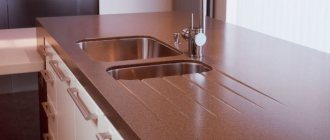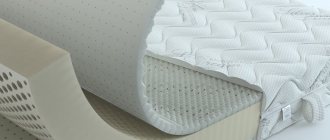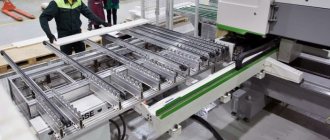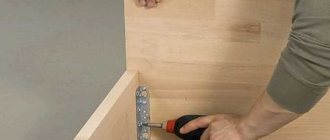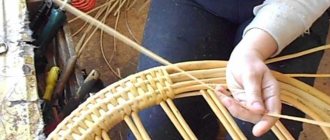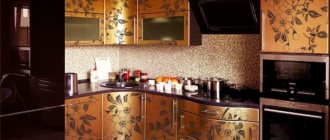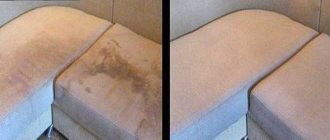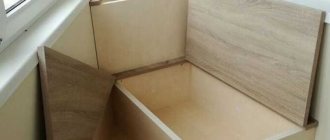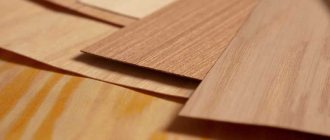0
10509
Wicker furniture is considered an excellent solution for different interiors and exteriors. It has many advantages and is presented in numerous forms; you can create wicker furniture with your own hands quickly and easily, and at the same time it can fully meet the needs of direct users. The whole process is divided into simple sequential steps, so if you first make a drawing, watch a training video and follow the instructions exactly, you will get a reliable and durable design.
Features of wicker furniture
The history of wicker furniture goes back thousands of years. Archaeologists often find it all over the world. Weaving from vines and other natural materials of plant origin was common in settlements located near bodies of water. The proximity of suitable raw materials in large quantities contributed to the fact that people made most of the products used in everyday life on their own.
Wicker furniture was used more often in the homes of the poor, as the cheapest and most accessible option. But quite quickly wealthy people and representatives of the nobility appreciated its beauty, functionality and possibilities of use in the interior. Since then, not only single craftsmen, but also entire artels, and later factories, have been engaged in weaving. There are even special schools of wicker weaving.
Prince Golitsyn brought the fashion for wicker furniture to Russia. Often traveling abroad, he appreciated the properties of wicker products and created an entire workshop for their production on his estate.
Wicker furniture can be a real work of art
Nowadays wicker furniture is very popular. Making it becomes a favorite hobby for many, even generating income. In addition, it has many advantages. These include:
- low cost, especially compared to products made from other natural materials;
- light weight, thanks to which you can easily move the furniture anywhere without outside help;
- environmental friendliness: wicker interior items not only look beautiful, but are also safe for health and do not have a specific odor;
- easy care: most often it is enough to wipe off dust from the furniture with a cloth dipped in water;
- durability, subject to high-quality weaving, performed according to all the rules.
True, there are also disadvantages that need to be taken into account. Furniture woven from wicker and similar materials is not resistant to the vagaries of the weather. In heavy rain it gets wet, and with prolonged exposure to sunlight and high temperatures it can dry out. This leads to loss of shape and disruption of the weave. Repairing a damaged product is very difficult. Therefore, it is not recommended to keep such furniture in open areas for a long time.
Nowadays wicker furniture is very popular, and many people are starting to make it at a professional level.
Types of wicker furniture
According to the structure and manufacturing principle, wicker furniture is divided into several types:
- Frameless products. In them, the rigidity of the structure is ensured by strong stick-ribs.
- Frame furniture, in which the body is made of durable material, such as steel rods. The metal parts of the frame are braided with wicker or other appropriate material.
- Wooden furniture in which the supporting frame is made of wooden sticks that impart rigidity and durability.
Pieces of furniture made of wicker or rattan - photo gallery
It is impossible to imagine a summer garden without comfortable pieces of wicker furniture
A rocking chair is the dream of anyone who loves comfort
Even a bed and an entire bedroom set can be woven from wicker or rattan
A cozy basket chair with a low base will appeal to kids and pets
A comfortable rattan hanging chair is a good place to relax after a hard day.
An airy openwork set of a sofa, armchairs and table will decorate any dining room
Video: wicker furniture made of wicker and rattan in the interior
Where to learn to weave furniture
The opportunity to find a craftsman who makes furniture with his own hands, and who is also willing to share his knowledge, is quite rare. In addition, many people who are passionate about weaving specialize in simpler products - baskets and dishes. Training courses on this craft are also extremely rare.
However, it is now possible to master the skill of weaving furniture completely independently . Firstly, on the Internet it is easy to find a variety of educational articles and videos, the authors of which explain all the basics of this matter in an accessible and step-by-step manner.
Secondly, weaving furniture is largely a creative process. Therefore, having learned the basics, most masters develop their own techniques, discover their own subtleties and constantly improvise. Do not forget that weaving furniture is not an exact science, but a craft where there is room for trial and experimentation.
Tools for work
Weaving from wicker is a labor-intensive task that requires scrupulousness. You just can't do it with your hands. You will have to stock up on a whole set of tools:
- special knives and garden shears for cutting and trimming twigs;
- ladder for sorting raw materials;
- large capacity, tank for soaking the rod;
- boiler for cooking and bleaching workpieces;
- squeezers for cleaning twigs from bark;
- splitters for dividing rods into parts;
- shof for obtaining planed strips;
- shmyg for figure processing, notching;
- iser for aligning rows;
- jigs for straightening frame blanks;
- pruner;
- measuring accessories - ruler or tape measure;
- pliers;
- saw on wood.
Weaving patterns and methods
There are several ways to weave furniture and interior items. Each combines decorativeness and functionality.
Weaving patterns - table
| Name of weaving | Peculiarities | |
| Solid thick | Simple |
|
| Rope |
| |
| Checkers |
| |
| Openwork | Diamond-shaped | The weaving is complex, creating geometric shapes and open cell patterns. |
| In the form of columns | ||
| Chess | ||
| Rosette | ||
| Ring | ||
| Spiral | ||
| Pigtail | The method is used for weaving decorative elements and in the design of edges. | |
| Bending | This type of weaving is used to decorate the edges of the product. | |
Weaving methods - photo gallery
This simple weaving pattern is easy for beginners to master.
The edges of the product are often braided
Rope weaving is created from two or more rods
Openwork weaving will give the product lightness, airiness and transparency.
Using checkerboard weaving, you can decorate furniture with a three-dimensional pattern.
Step-by-step master class on weaving for beginners
The general algorithm of actions is simple: you need to decide what the structure will be made of and what the braid will be supported on. There are more than enough step-by-step instructions on how to make wicker furniture. Most of them have been tested by many craftsmen in practice and found to be effective.
Artificial rattan stool
For work you will need: a wooden beam, tools and materials for processing it, self-tapping screws, strong non-stretchable tape, a furniture stapler, polyrattan, a knife. During assembly and weaving, a simple pattern of actions is followed. Step-by-step master class:
- A stable frame with additional rigidity bars is made from timber. All elements are connected with self-tapping screws, the structure is impregnated with an antiseptic.
- The seat is reinforced with tapes attached to the beam with furniture staples and screws. If you have experience, you can weave beautiful braids or strands from poly rattan for these purposes.
- The rattan is cut into short and long strips, laid tightly in a 2:1 alternation ratio and secured with staples.
- Ribbons are prepared for continuous transverse weaving of a different shade. The blanks are woven with the pattern shifted by 1 strip.
- The ends are finally fixed on the back side of the beam and trimmed.
- The sidewalls are weaved from longer strips (up to 5–7 m, depending on the experience of the craftsman).
- Two vertical strips of artificial rattan are fixed and hidden on the legs.
If desired, the legs can be braided in a circle with a single-color material.
Chair made of wicker
Do-it-yourself weaving of willow furniture begins with the preparation of raw materials and frame; work is carried out in stages:
- The rods are soaked in hot water for at least a day and dried.
- A rectangular frame of a chair seat is knocked together from 4 even pieces of wood; 4 support legs are attached in front and behind with self-tapping screws (taking into account the need for armrests or without them).
- The assembled structure is reinforced from below with 4 horizontal stiffeners (legs). The upper arch of the back is secured after weaving it, last.
- Vertical risers are attached to the back of the frame.
- The seat, side elements, lower part (if available), and back are woven in sequence, with the obligatory sealing of each row. To simplify the work, the product is turned over. The last to be braided are the legs.
- The joints with the edges are additionally braided with flexible willow twigs.
- The stability of the structure is checked and minor defects are eliminated.
Features and advantages of pine furniture, important nuances of choice
Using this algorithm, both ordinary chairs with a back and volumetric chairs are woven; the difference is manifested in the shape of the furniture frame and the presence of armrests. If there is no weaving in the lower part or openwork weaving is performed, the requirements for the stability of furniture legs become more stringent.
Coffee table made from newspaper tubes
To obtain a round table with a double tabletop, in addition to newsprint, you will need durable three-layer cardboard. You also need to prepare moisture-resistant wallpaper to match the future color, 4 round hollow cardboard or aluminum tubes, knitting needles No. 1.8–2, a screwdriver, Titan glue, a universal primer, stain and acrylic varnish. The work is carried out in the following sequence:
- Using knitting needles and a screwdriver, thick paper blanks are made.
- In a plastic container, prepare a solution of stain (1 l), acrylic varnish and primer (1 tablespoon each) for soaking the tubes for 5–20 minutes (the color of the blanks may vary).
- The painted rods are dried for 3–12 hours (depending on the humidity level or time of year), and placed in a bag.
- The upper tabletop of the table is prepared: two circles of the same diameter are cut out of cardboard, the upper part is braided in a circle (the weaving pattern is a rope), 4 round holes are cut out in the lower part to secure the legs. The bottom edge with the area in the center is covered with wallpaper.
- Round furniture supports are braided with paper rods (1 cm at the top remains open), all finished elements are connected and glued.
- A round inner shelf is made from the tubes, secured to the crosspiece with an awl.
- The legs are decorated with inserts of a different color (optional).
In order for a wicker table to last as long as possible, it must be varnished.
Finishing wicker furniture
When a chair, table, sofa or other item is ready, all that remains is to give the item a marketable appearance. Finishing work is carried out in several stages:
- Inspection for various defects, eliminating them: correct the uneven density of the weaving by slightly moving the rods, align the legs, cut off the tips of the rods and smooth out the unevenness with fine-grained sandpaper.
- Bleaching and painting. To make the product white, it is treated with lime or sulfur dioxide. To give a different color, use regular paint. They also use decoctions of onion peels, wolf berries, heather, alder bark or moss, if you like naturalness and environmental friendliness.
- Varnish coating. In order not only to preserve the texture of the material used, but also to make it even stronger, apply 2-3 layers of varnish (each subsequent after the previous one has completely dried).
Willow-willow
To make wicker furniture you need a vine. Experts advise paying attention to willow. Fortunately, it grows almost everywhere. True, you need to cut the rods for weaving wisely. In order to preserve their revival without damaging the tree or shrub.
“The twig should be cut with a sickle or knife at an angle of 30-60 degrees to the axis of the branch, and not with an ax,” advises Yegor Kozlov. - And closer to the stump, leaving two rods on each stump. Afterwards, leave them alone for two to three years until new ones sprout. The butt (the remainder of the rod) should be small, about two centimeters.
A good material for weaving is hemp willow, which grows along rivers, lakes or in floodplains. Three-year-old twigs are usually used for the furniture frame, and one-year-old vines are used for the weaving itself. It is considered good luck to find a pointed willow, known as a hybrid of goat willow and twig willow. Its vine is considered a very high quality material.
Harvesting willow vines should begin in the second half of October. They finish harvesting the vines in the spring, when white fluffy buds appear.
Cutting willow in spring and summer is not recommended for environmental reasons. The wound on the butt does not heal for a long time and oozes. In this case, you can’t count on the appearance of new branches.
“There are nuances here,” advise Yegor Kozlov. — Winter harvesting produces a cream-colored vine, and summer harvesting produces white, the most sought-after. Before cutting the vine, it is necessary to evaluate its strength. To do this you need to bend the branch 90 degrees. If the vine is not broken, then the willow bush is suitable for harvesting.”
Caring for wicker and rattan products
Wicker furniture requires special care, which is due to the characteristics of the material used: wicker and rattan can become very fragile if not used correctly.
- At least once a week, wipe off dust from products with a damp cloth.
- If a large amount of water gets on wicker furniture, first wipe thoroughly with a dry cloth, then take it out into the air to allow the product to dry naturally. Do this immediately.
- Vacuum wicker items only using soft attachments.
- If you notice that the braid has begun to dry out, spray it with linseed oil from a spray bottle.
- To protect wicker furniture from moisture, treat it with tung oil or tung-based products twice a year. Do this at the beginning of the season (before moving furniture outside) and at the end.
To protect wicker furniture from high humidity, treat it with tung oil-based products.
Wicker furniture is a rather difficult product to repair. In the event of a breakdown, it is difficult to find a repairman who will undertake the repair. Therefore, proper care is mandatory and necessary for products made from wicker and rattan.
What is the difference between RAMMUS eco-rattan and other types of artificial rattan?
Foreign and many domestic manufacturers of wicker furniture made from artificial rattan use poly-rattan or technorattan - a polymer material similar in appearance to RAMMUS eco-rattan. Most wicker furniture produced in Russia and other countries are products made from synthetic rattan, made from recycled materials and poorly suited for use in the domestic climate. Under the influence of temperature changes, the structure of European artificial rattan is destroyed, the tension of the rattan fibers weakens and, as a result, the service life of wicker furniture is reduced to 5 years.
The RAMMUS company is the only Russian manufacturer of eco-rattan furniture that has developed its own formula of polymer rattan, which is called “RAMMUS-fiber”. Wicker furniture from the manufacturer RAMMUS is qualitatively different from products from other companies thanks to eco-tangent, made from environmentally friendly, primary polymer raw materials.
Due to technological innovations, RAMMUS eco-rattan has improved characteristics:
- Stable in the range from -50 to +80 °C, withstands operation in the subtropical, temperate, and subarctic zones of Russia.
- In terms of wear resistance and strength, it exceeds foreign analogues by 1.5 times.
- Under the influence of climatic factors, the structure does not change - it does not dry out, does not crack.
- Absolutely harmless and approved for contact with food.
- The environmental friendliness and hypoallergenic nature of eco-rattan make it possible to use products made from it in medical and children's institutions.
In addition to the distinctive properties that distinguish eco-rattan from other types of artificial rattan, RAMMUS fiber has a number of standard characteristics. It is moisture-resistant and fireproof, resistant to chemically aggressive environments and UV radiation, prevents the proliferation of pathogenic flora and does not require special care. Visually, eco-rattan RAMMUS reliably imitates the texture and color scheme of natural rattan and is a textured fiber in natural shades: milky, beige, brown, light gray and anthracite gray. The texture and color palette of tubular eco-rattan imitates natural elements - twigs, branches. wicker furniture seems to disappear into the garden landscape.
Assortment of wicker furniture from the manufacturer RAMMUS
Wicker furniture produced by the Russian factory RAMMUS can be used in residential interiors of apartments, country cottages and country houses, as well as in public spaces of hotels and catering establishments, medical institutions and offices. Due to their immunity to negative climatic factors, products made from RAMMUS fiber are successfully used for arranging exterior spaces for private and public purposes: garden plots, summer areas of cafes and restaurants, patio areas and terraces.
Artificial rattan furniture produced by the Russian factory RAMMUS is a variety of wicker products for various functional purposes:
- Furniture for sitting and relaxing. Sofas (including modular), armchairs (including hanging), banquettes, ottomans, swings.
- Lunch groups. Dining and coffee tables, chairs, bar counters.
- Furniture for storage. Wardrobes, chests of drawers, TV stands, baskets, chests.
- Sets of children's furniture. Sofas, armchairs, tables, chairs.
- Furniture for a beach holiday. Sun beds, sun loungers, tables for sun loungers.
- Furniture for bars and restaurants. Bar sets and counters, storage furniture, waiter trolleys.
Design of wicker furniture made from eco-rattan - RAMMUS fibers
- The RAMMUS factory offers a series of wicker furniture for relaxation - sofas and armchairs - in various stylistic solutions. These are modern soft corners with strict forms, sets of classic furniture with smooth curves, original sofas and armchairs in a provincial spirit. A variety of textiles for covers allows you to give your leisure furniture an individual look that harmonizes with any color scheme of the interior or exterior.
- The RAMMUS furniture collection for beach holidays includes sun loungers and deck chairs made from eco-rattan. Plastic forms of furniture, created taking into account all ergonomic standards, contribute to complete relaxation during rest. RAMMUS beach wicker furniture is designed in a modern, classic or avant-garde design, which simplifies the selection of a furniture set for arranging the pool area.
- Wicker furniture for bars and restaurants RAMMUS is designed in a minimalist style - these are bar counters and chairs, benches and stools, sofas and tables of laconic shape. High ergonomics, convenience and wear resistance allow you to install RAMMUS bar furniture not only in the interior of a catering establishment, but also in outdoor areas.
- RAMMUS wicker children's furniture sets are designed taking into account the physical and psychological characteristics of children. The shape, proportions and load-bearing capacity of sofas, armchairs, tables and chairs correspond to the dimensions and weight of children of a certain age group. The color palette of children's furniture includes rich and cheerful shades.
